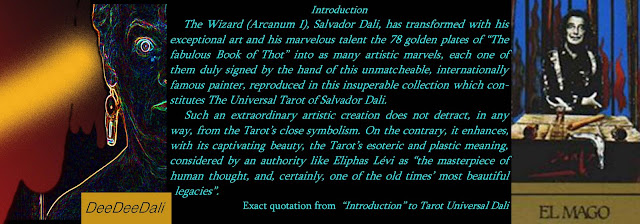



Four Aces. Hard to imagine a more auspicious Tarot spread to announce Beginnings for the New Year.
 Beginning with Tarot Universal Dali's Ace of Cups, as does GALA'S GRAIL A Dali Codex , with author Kora Silver's promise, " ...we shall embark on a most curious tale of an unorthodox Grail."
Beginning with Tarot Universal Dali's Ace of Cups, as does GALA'S GRAIL A Dali Codex , with author Kora Silver's promise, " ...we shall embark on a most curious tale of an unorthodox Grail."The figures in the reversible goblet illusion Silver pegs as Tristan and Iseult . Or as named by The Magician himself in his Tristan and Isolde 1944

Cups are the suit of love, emotions and dreams, writes Rachel Pollack. The Ace is "the source of the suit," she elaborates in Salvador Dalli's Tarot. The Ace of Cups speaks to launching these ephemeral pursuits.
 Swords, Ms. Pollack writes of Dali's Ace, represent the "analytical mind and the crown the material world. The intellect, and not the emotions, cuts through to the truth. The hand grasps the blade and not the handle, indicating the pain of seeing through illusions."
Swords, Ms. Pollack writes of Dali's Ace, represent the "analytical mind and the crown the material world. The intellect, and not the emotions, cuts through to the truth. The hand grasps the blade and not the handle, indicating the pain of seeing through illusions."Also appearing in Tarot Universal Dali's Ace of Swords is the familiar woman in white, arms raised
 , following her shadow, her body patterns the bell of the chapel on the road to Dali and Gala's home in Cadaques. -- as seen in Suburbs of a Paranoia-Critical Town: Afternoon on the Outskirts of European Hsitory 1936
, following her shadow, her body patterns the bell of the chapel on the road to Dali and Gala's home in Cadaques. -- as seen in Suburbs of a Paranoia-Critical Town: Afternoon on the Outskirts of European Hsitory 1936 What a delight! This Ace of Wands is from Georges de La Tour, The Cheat With the Ace of Clubs from the late 1620s.
What a delight! This Ace of Wands is from Georges de La Tour, The Cheat With the Ace of Clubs from the late 1620s.
Wands is the suit associated with Clubs in the modern card suits, Cups with Hearts, Swords-Spades, Pentacles-Diamonds.
Wands are the suit of fire -- depicted via the combustibility of wood which Dali carries further turning leaves of gold out upon the Wands of Tarot Universal Dali. Wands are growth, energy, powerful movement -- beginnings.
But just as Swords illuminate the pain from the exposure of illusions, which is always a hallmark of a new beginning; here Dali's Wands warn of the unseen that always remains below the surface -- here the cheating ace is hidden even from the viewer.
But as for the Ace of Pentacles, there can be no better wishes for a new year of beginnings as what Ms. Pollack writes of this Dali Ace, from Salvador Dali's Tarot:
 "...All the Aces represent something given to us by life, which is why the Tarot depicts a hand emerging from some hidden source. But Pentacles especially, with their connotations of wealth and material satisfaction, come to us not as a reward for some moral virtue, but as a gift generated by the concealed workings of the world (concealed not by some spell, but by our limited perceptions of cause and effect). Trees grow alongside the pentacle, while the arm rests on a tree whose trunk and roots penetrate a mist. The wonders and origins of nature reach beyond our understanding."
"...All the Aces represent something given to us by life, which is why the Tarot depicts a hand emerging from some hidden source. But Pentacles especially, with their connotations of wealth and material satisfaction, come to us not as a reward for some moral virtue, but as a gift generated by the concealed workings of the world (concealed not by some spell, but by our limited perceptions of cause and effect). Trees grow alongside the pentacle, while the arm rests on a tree whose trunk and roots penetrate a mist. The wonders and origins of nature reach beyond our understanding."The year opens with four Aces. One. One. One. One. Hardly a more auspicious opening possible to the new year which is surely beyond our understanding and filled with both illusions and the unveiling of illusions; of pain and discovery; of new beginnings.
Happy New Year 1.1.11































